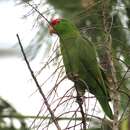Biology
(
الإنجليزية
)
المقدمة من Arkive
Recognisable in flight by its rapid and shallow wing beats, the green-cheeked Amazon gathers in large flocks which fly in formation, feeding together and calling 'kee-craw craw craw' in chorus, particularly in the morning and evening (8). They pick at seeds, berries, flowers and nectar, wastefully pecking at them and dropping the rest. Between March and May, green-cheeked Amazons court and mate in monogamous pairs, nesting together in loose colonies in large, old trees (5). Between two and five eggs are laid each year, hatching after about 26 days. The young will leave the nest after around 68 days (2). During the non-breeding season, the green-cheeked Amazon is nomadic and moves to higher elevations (5) in flocks of up to 100 (9).
Conservation
(
الإنجليزية
)
المقدمة من Arkive
Whilst protected under international law (Appendix I of the Convention on International Trade in Endangered Species) and Mexican law (Nom 059), as well as occurring in two of Mexico's Biosphere Reserves, poaching is still a massive problem. It is thought that awareness of the danger posed to this species is growing among rangers, but measures to halt its decline it have not yet been taken (5).
Proposed actions to prevent the extinction of this parrot in the wild include: monitoring populations to determine the extent of declines, identifying the highest nesting aggregations for immediate protection, and educating ranchers to halt poaching and regenerate the habitat (10).
Description
(
الإنجليزية
)
المقدمة من Arkive
The green-cheeked Amazon is a striking bird with a large head and a big, yellow bill (6). The feathers are mainly green, with black edges, but the forehead is bright red (2). A half-moon shaped blue-violet band runs from the cheeks around the back of the head (7). The primaries have blue tips and the tail is tipped with yellow (2). The legs are grey-green (2) and the feet have two toes facing forwards and two toes facing backwards (6).
Habitat
(
الإنجليزية
)
المقدمة من Arkive
The green-cheeked Amazon inhabits arid tropical lowlands, dry open pine-oak ridges and tropical deciduous forests in its natural range. It has settled in suburban areas with mature trees and parks in the new areas of its range (8).
Range
(
الإنجليزية
)
المقدمة من Arkive
The natural range of this bird is small areas of Mexico, but it has been introduced to Puerto Rico and the sates of Florida and California, USA, where it has become naturalised (1).
Status
(
الإنجليزية
)
المقدمة من Arkive
The green-cheeked Amazon is classified as Endangered (EN A2bcd + 3bcd) on the IUCN Red List 2004 (1) and is listed on Appendix I of CITES (4). It is also listed as Endangered on Mexico's Threatened Species List 'Nom 059' (5).
Threats
(
الإنجليزية
)
المقدمة من Arkive
With a street value of between $900 and $1200 (3), the green-cheeked Amazon is massively exploited for the pet trade. As a beautiful bird, which talks occasionally, the green-cheeked Amazon is a popular pet and consequently thousands of chicks are taken from nests each year. Adding to this problem, poachers often fell or damage nesting trees, preventing their use in subsequent breeding seasons. With little else affecting their decline, the green-cheeked Amazon is an endangered species as a result of supplying humans with exotic pets (5).

